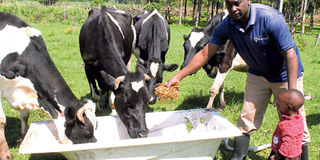Premium
Vet on call: All you need to know on diarrhoea in cows

Reuben Rono feeds his dairy cattle in his farm in Kirobon, Nakuru. Dairy cattle farmers should understand that severe mastitis, especially caused by Escherichia coli, requires combined treatment into the udder and injections using well-selected antibiotics because many bacteria types have developed resistance to the commonly used antibiotics. PHOTO | JOHN NJOROGE | NMG
What you need to know:
- From my experience, animals that have mastitis with fever and diarrhoea don’t usually recover with udder infusion of antibiotics alone.
- Severe mastitis, especially caused by Escherichia coli, requires combined treatment into the udder and injections using well-selected antibiotics because many bacteria types have developed resistance to the commonly used antibiotics.
- The disease may either develop into a pneumonia, diarrhoea or abscesses because of spread of toxins and bacterial to the rest of the body.
- If no antibiotics are given by mouth, then the intestinal bacteria will keep infecting the intestinal walls every time the injected antibiotic concentration wanes in the blood.
Last month, Joe, a dairy farmer from Kiambu, called and said he had a very strange case.
His best Friesian cow that used to produce 30 litres of milk daily had been on treatment for a month but the situation appeared to be worsening.
The cow initially had severe mastitis, which was treated without success. It later developed diarrhoea and again was treated.
The diarrhoea stopped but resumed with severe force on the day he called me. “This cow is pushing dung over two metres away,” said Joe.
Medically, we call this “explosive diarrhoea”. The intestinal content is voided with a lot of force and comes out as a liquid projectile stream.
It is caused by strong intestinal and abdominal muscle contractions as the body attempts to completely empty the bowels of the offending material.
I visited Joe’s farm in the company of two veterinary doctor interns. It was clear Joe’s cow had been sick for some time.
The body condition was poor and the udder was asymmetrical. The left hind quarter was heavily swollen and hard to touch.
It produced beer-coloured fluid with speckles of pus. I did a standard California Mastitis Test (CMT) on the other quarters and the results showed they were all infected.
The animal had a faster breathing rate of 48 per minute and a rapid weak heartbeat. The lung sounds and body temperature were normal; that was a promising finding.
At the time of our arrival, the cow was down and could not stand up. It was dehydrated as the eyes were sunken. The skin had bruise wounds where bones were prominent.
Rectal examination revealed a lot of fluid bowel content that came out as a projectile even when the animal was down.
The mucous membranes of the eyes and gums were pale, indicating the animal had low level of blood. This was expected from the long-standing nature of the illness.
CHANCE OF RECOVERY
The constant diarrhoea meant the cow was unable to digest and absorb the food properly. She was ejecting most of the nutrients and water in the diarrhoea. The lining of the intestines felt normal, though that could not be conclusive.
I took a blood sample for laboratory analysis. I also reviewed results of laboratory analysis of milk from the cow and two others that had been obtained the week before.
They showed the cows had mixed-infection mastitis caused by Escherichia coli, Staphylococcus bacteria and some fungi. The bacteria were resistant to the most commonly used drugs for mastitis and other diseases.
The doctor who had been treating the animal said the case had proved difficult.
Indeed, this was a truly complicated case. The cow had both severe mixed microbial mastitis and bacterial diarrhoea.
The bad news was that the cow had badly wasted and was now not eating. If that continued, she was unlikely to recover.
Further, the cow may not resume milk production during the current lactation even if she recovered. On the brighter side, the cow had some chance of recovery.
Medically, we call this a guarded prognosis meaning that the case could either die or recover but the situation was more grave than optimistic.
I made the conclusion because the normal lung sounds and body temperature indicated the disease was still confined to the udder and the intestines.
The cause of the severe disease signs was possibly toxins being produced from the infection especially by Escherichia coli bacteria.
Stress caused by the infection and wasting could also have resulted in rapid growth of the bacteria in the intestines and their toxins were causing the explosive diarrhoea.
“Our best option here is the administration of appropriate antibiotic treatment for the udder and intestines given by teat infusion, mouth and injection of both into the blood stream and the muscles,” I explained to the farmer and the interns.
The aim was to kill the bacteria quickly so that we could stop toxin production. I also told them we needed to rehydrate the cow by mouth since the dehydration had not reached the threshold for intravenous fluids.
INFECTING THE INTESTINAL WALLS
I gave the cow an antibiotic via the jugular vein. I also gave the same antibiotic but in a bolus form by mouth and showed the farmer how to repeat the oral treatment for three days.
Next, the interns injected long acting antibiotics into the muscles of the neck. They also gave vitamin injection and an anti-inflammatory.
I washed the teats, stripped the udder fully and infused into each quarter a tube of a combination mastitis drug. I did the same for the other two cows that had mastitis.
I left the farmer with mastitis tubes to treat all the three cows for three days continuously.
Finally, we gave the cow five litres of water by mouth and advised the farmer to give at least 20 litres of water daily if the cow was not able to take water voluntarily. Fortunately, the cow shook her head and stood up after drinking the five litres we gave.
Two weeks later, the cow recovered but the milk had dried up completely. With diseases, you win some, lose some.
Severe mastitis, especially caused by Escherichia coli, requires combined treatment into the udder and injections using well-selected antibiotics because many bacteria types have developed resistance to the commonly used antibiotics.
From my experience, animals that have mastitis with fever and diarrhoea don’t usually recover with udder infusion of antibiotics alone.
The disease may either develop into a pneumonia, diarrhoea or abscesses because of spread of toxins and bacterial to the rest of the body.
When there is diarrhoea, appropriate antibiotics should also be given by mouth for at least three days. This is because bacteria in the intestinal space cannot be killed by injected antibiotics.
If no antibiotics are given by mouth, then the intestinal bacteria will keep infecting the intestinal walls every time the injected antibiotic concentration wanes in the blood.
This explains the recurrent diarrhoea in Joe’s cow. Previous treatment had omitted antibiotics by mouth and into the blood.





